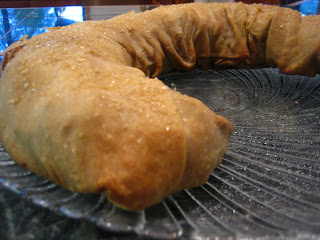 I'm just getting this challenge finished on the reveal day--yes, the month flew by and before I knew it, today was here and I still needed to actually make the strudel. Before I continue with my explanation, let me officially introduce "the challenge".
I'm just getting this challenge finished on the reveal day--yes, the month flew by and before I knew it, today was here and I still needed to actually make the strudel. Before I continue with my explanation, let me officially introduce "the challenge".The May Daring Bakers’ challenge was hosted by Linda of make life sweeter! and Courtney of Coco Cooks. They chose Apple Strudel from the recipe book Kaffeehaus: Exquisite Desserts from the Classic Cafés of Vienna, Budapest and Prague by Rick Rodgers.
I have to admit that I was a bit nervous about making strudel. While I was in culinary school we had watched a demonstration of one being made from start to finish. It was very exciting to watch as our cakes class chef and his two assistants stretched the dough to be paper thin and I had furiously scribbled over six pages of notes, making sure not to miss a single detail of the experience. I remember that the dough was stretched out to be as long as the eight-foot table and the width of about four-feet. It was amazing! I also made a mental note that I probably wouldn't be attempting that anytime soon. That was over five years ago and the memory of that observation has stayed with me.
When the challenge was revealed at the beginning of the month, I immediately thought about that demo from school and I was already feeling stressed. As the month continued, business was increasing (which is a really good thing), but I kept putting it off and so here we are. I finally stopped all the other projects I was working on today and by 5:15 pm, I had begun. By 5:25 pm, the dough was made. I started to laugh when I realized how this wasn't going to be as complicated as I originally thought. Here's the recipes and some pictures from my baking experience.
Preparation time
Total: 2 hours 15 minutes – 3 hours 30 minutes
15-20 min to make dough
30-90 min to let dough rest/to prepare the filling
20-30 min to roll out and stretch dough
10 min to fill and roll dough
30 min to bake
30 min to cool
15-20 min to make dough
30-90 min to let dough rest/to prepare the filling
20-30 min to roll out and stretch dough
10 min to fill and roll dough
30 min to bake
30 min to cool
Strudel dough from “Kaffeehaus – Exquisite Desserts from the Classic Cafés of Vienna, Budapest and Prague” by Rick Rodgers
1 1/3 cups (200 g) unbleached flour
1/8 teaspoon salt
7 tablespoons (105 ml) water, plus more if needed
2 tablespoons (30 ml) vegetable oil, plus additional for coating the dough
1/2 teaspoon cider vinegar
1. Combine the flour and salt in a stand-mixer fitted with the paddle attachment. Mix the water, oil and vinegar in a measuring cup. Add the water/oil mixture to the flour with the mixer on low speed. You will get a soft dough. Make sure it is not too dry, add a little more water if necessary.Take the dough out of the mixer. Change to the dough hook. Put the dough ball back in the mixer. Let the dough knead on medium until you get a soft dough ball with a somewhat rough surface.

2. Take the dough out of the mixer and continue kneading by hand on an unfloured work surface. Knead for about 2 minutes. Pick up the dough and throw it down hard onto your working surface occasionally.Shape the dough into a ball and transfer it to a plate. Oil the top of the dough ball lightly. Cover the ball tightly with plastic wrap. Allow to stand for 30-90 minutes (longer is better).
3. It would be best if you have a work area that you can walk around on all sides like a 36 inch (90 cm) round table or a work surface of 23 x 38 inches (60 x 100 cm). Cover your working area with table cloth, dust it with flour and rub it into the fabric.

Put your dough ball in the middle and roll it out as much as you can.Pick the dough up by holding it by an edge. This way the weight of the dough and gravity can help stretching it as it hangs. Using the back of your hands to gently stretch and pull the dough. You can use your forearms to support it.
4. The dough will become too large to hold. Put it on your work surface. Leave the thicker edge of the dough to hang over the edge of the table. Place your hands underneath the dough and stretch and pull the dough thinner using the backs of your hands. Stretch and pull the dough until it's about 2 feet (60 cm) wide and 3 feet (90 cm) long, it will be tissue-thin by this time.
4. The dough will become too large to hold. Put it on your work surface. Leave the thicker edge of the dough to hang over the edge of the table. Place your hands underneath the dough and stretch and pull the dough thinner using the backs of your hands. Stretch and pull the dough until it's about 2 feet (60 cm) wide and 3 feet (90 cm) long, it will be tissue-thin by this time.

*This dough should be so thin that you should be able to read something under it--my business card was handy and it was a great way to check that the dough was stretched out thin enough. (This was my favorite part of the process--ironically, it had been the part I was stressed about doing.)


Cut away the thick dough around the edges with scissors. The dough is now ready to be filled.
*Jill's Variation: I didn't use this apple mixture recipe (below)--instead I used an apple filling I made last fall from our own backyard apples, that I had in the freezer. This actually saved me some time today, since I did wait till the last few hours of this challenge. Here's a picture of one of our apple trees that the filling came from:

Apple strudel from “Kaffeehaus – Exquisite Desserts from the Classic Cafés of Vienna, Budapest and Prague” by Rick Rodgers
2 tablespoons (30 ml) golden rum
3 tablespoons (45 ml) raisins
1/4 teaspoon ground cinnamon
1/3 cup plus 1 tablespoon (80 g) sugar
1/2 cup (1 stick / 115 g) unsalted butter, melted, divided
1 1/2 cups (350 ml) fresh bread crumbs
strudel dough (recipe above)
1/2 cup (120 ml, about 60 g) coarsely chopped walnuts (I did add the walnuts and it added a nice texture to the strudel filling)
2 pounds (900 g) tart cooking apples, peeled, cored and cut into ¼ inch-thick slices (use apples that hold their shape during baking)
1. Mix the rum and raisins in a bowl. Mix the cinnamon and sugar in another bowl.
2. Heat 3 tablespoons of the butter in a large skillet over medium-high. Add the breadcrumbs and cook whilst stirring until golden and toasted. This will take about 3 minutes. Let it cool completely.
3. Put the rack in the upper third of the oven and preheat the oven to 400°F (200°C). Line a large baking sheet with baking paper (parchment paper). Make the strudel dough as described above. Spread about 3 tablespoons of the remaining melted butter over the dough using your hands (a bristle brush could tear the dough, you could use a special feather pastry brush instead of your hands). Sprinkle the buttered dough with the bread crumbs.

Spread the walnuts about 3 inches (8 cm) from the short edge of the dough in a 6-inch-(15cm)-wide strip. Mix the apples with the raisins (including the rum), and the cinnamon sugar. Spread the mixture over the walnuts.

4. Fold the short end of the dough onto the filling. Lift the tablecloth at the short end of the dough so that the strudel rolls onto itself. Transfer the strudel to the prepared baking sheet by lifting it. Curve it into a horseshoe to fit. Tuck the ends under the strudel. Brush the top with the remaining melted butter.

5. Bake the strudel for about 30 minutes or until it is deep golden brown. Cool for at least 30 minutes before slicing. Use a serrated knife and serve either warm or at room temperature. It is best on the day it is baked.
*I found that the baking time directions were a bit misleading. After 30 minutes, my strudel was no where close to a "deep golden brown", so I continued to bake it in 5 minute increments and checking it each time. After another 15-20 minutes I decided to take it out, even though it wasn't a "deep golden brown".

*I added some raw cane sugar after brushing the dough with the melted butter.
*Here is a picture of the strudel after cutting into it and I think it baked for much too long (trying to get that "deep golden brown" color) and it seemed to be overly crispy and not in the "flaky" good way. Also, from this picture you can see that the bread crumbs were out of control in the amount given in the recipe. If I were to make another strudel using this recipe, I would cut the bread crumb amount to half and only bake it for 30-35 minutes. Although I was a little disappointed with the dough texture, I was happy with the filling. Next time I will try a few more filling variations.






















